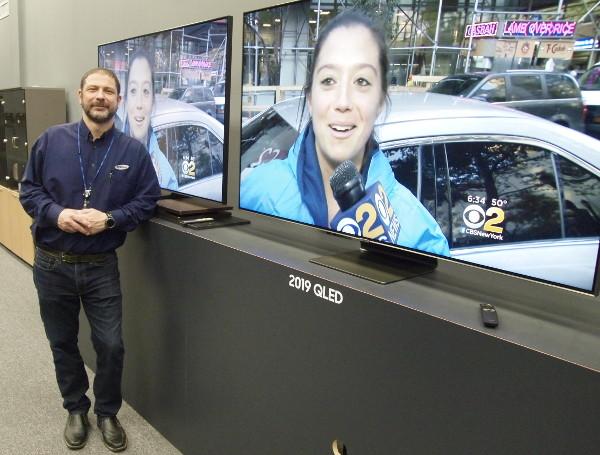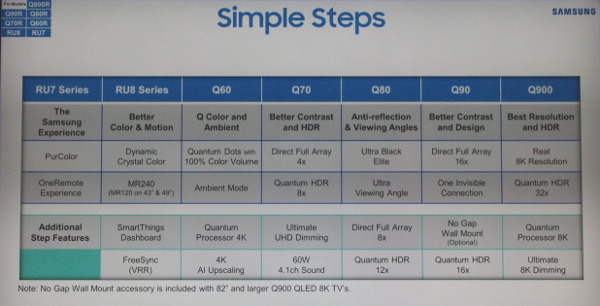Samsung TVs Get HDMI 2.1, Adaptive Sound & More

Key features making their Samsung debut include HDMI 2.1 capabilities, sound that adapts to a room’s acoustics and to different scenes, screens that automatically adjust brightness based on ambient light levels, voice control from Google Assistant- and Alexa-enabled smart speakers, and the Apple TV app. The app, due in the spring as an update, accesses a variety of streaming services, including Apple’s planned Apple TV+ original-content service.
In other upgrades, Samsung built its Bixby virtual assistant into more TVs, expanded its selection of TVs with full-array local dimming (FALD) to enhance contrast, and expanded its selection of big-screen TVs by offering 75-inch or larger sizes in its 4K RU800 series and in all four Q series of step-up 4K quantum-dot QLED TVs. The entry-level 4K RU7100 series also adds a 75-inch model.
The company released many top-level details at CES but hosted a follow-up press event yesterday at its Quality Assurance Labs in Pine Brook, N.J., to talk up advances that might have been overlooked during the CES crunch. Samsung’s senior manager for home entertainment training, Scott Cohen (pictured above), presided.
What’s New for 2019
Samsung’s 2019 lineup includes the 4K entry-level RU7100/7300 series, the 4K RU8000 Premium UHD series, four series of quantum-dot (QLED) panels that deliver a wider color gamut (Q60, Q70, Q80, and Q90), and an expanded 8K series (Q900), which also features QLED technology. The décor-focused Frame and Serif lines likewise feature QLED panels. All are smart TVs.
Samsung didn’t announce pricing or availability of its two latest modular 4K microLED TVs at 75 and 219 inches, which were unveiled at CES and will join a current 146-inch 4K microLED TV. The company also didn’t announce pricing or availability of a 98-inch 8K model unveiled at CES and due sometime later this year to join four smaller 8K models.
Here’s the scoop on what’s new to the lineup:
HDMI 2.1: Samsung brought key HDMI 2.1 features to its 4K and 8K QLED TVs even though the group licensing HDMI technology hasn’t released compliance-testing specifications for every HDMI 2.1 feature. “The HDMI 2.1 Compliance Test Spec was released last year, but not all features have tests defined in it, and those will come out in phases,” said a spokesman for the HDMI Licensing Administrator (LA). “Features supported in the CTS so far are eARC [enhanced Audio Return Channel] and the connectors, and that’s all that can be tested and certified.”
In Samsung’s 2019 lineup, the number of HDMI 2.1 features increases in steps, with the entry-level RU7100/7300 series featuring auto low latency mode (ALLM) for responsive game play. The RU8000 series adds dynamic metadata and, for gamers, variable refresh rates. The Q60, Q70, Q80, Q90, and Q900 series boost frame rates to 120fps for 2K and 2.5K content, and the Q90 and 8K Q900 series boosts 4K frame rates to 120fps. The 8K series also supports 8K at 60fps through its HDMI inputs.
“HDMI 2.1 can be claimed if any of its sub-features are supported,” though on 8K TVs, “8K at 60 frames per second is mandatory,” Cohen noted. Samsung believes the Samsung TV’s HDMI 2.1 features will pass compliance testing, he added.
No Samsung TVs, however, support eARC (enhanced Audio Return Channel) because smart-TV streaming services are delivering immersive Dolby Atmos metadata via Dolby Digital Plus soundtracks, Cohen said. These soundtracks pass through a TV’s standard ARC output to ARC-equipped AVRs and soundbars.
Enthusiasts who prefer higher performance immersive surround sound from a Blu-ray or 4K Blu-ray player are more likely to connect their players directly to HDMI-equipped AVRs or soundbars that decode wide-bandwidth Dolby TrueHD with Atmos metadata. That’s because a TVs’ ARC outputs don’t have the bandwidth to pass wide-bandwidth soundtracks from players connected to the TV’s HDMI input.
Adaptive Brightness: This new feature automatically adjusts TV brightness to room lighting levels while maintaining accurate tone mapping, Cohen said. The company’s 4K and 8K quantum-dot QLED TVs, including the 4K Frame and Serif, dim during bright scenes in dark rooms and brighten up in rooms with high ambient lighting levels, he explained.
Adaptive Sound: Sound also gets adaptive for the first time. In all 4K and 8K TVs, including the 4K Serif and Frame TVs, Samsung uses artificial intelligence (AI) to automatically optimize sound on a scene-by-scene basis for scenes with dialog, music, or special effects. The TVs also calibrate sound automatically to compensate for viewing distance and room echoes and reflections, thanks to remotes equipped with far-field microphones that detect test signals emitted by the TVs.
New Panels: A new panel design in the Q80, Q90, and Q900 series adds Ultra Black Elite anti-reflection technology to reduce glare for better daytime viewing and improved black levels. These panels also deliver “ultra-wide” viewing angles so that colors aren’t washed out for viewers sitting far to one side of the screen or the other.
Apple Features: The Apple TV app and Apple’s AirPlay 2 come to all 4K and 8K TVs, including the Serif and Frame TVs. AirPlay 2 enables screen mirroring from Apple devices without the need for an Apple TV box, complementing mirroring from Android devices.

Voice Control: Also new in 2019 is voice control of all 4K and 8K TVs via smart speakers equipped with the Amazon Alexa and Google Assistant virtual assistants. Cohen cited the high penetration rate of the smart speakers and consumer demand for Samsung-TV compatibility.
Voice commands carried out by Alexa and Google are limited to turning the TVs on and off, but consumers who want voice control over more TV functions are getting more opportunities to do so now that Samsung has built its Bixby virtual assistant into more TVs. All 4K and 8K TVs get Bixby except for the entry-level RU7100/7300 4K series. With Bixby, consumers can select specific movies and TV programs by voice, search for movies by genre, and even ask for a list of available top grossing films in a particular year or movies featuring a particular actor, Cohen said.
A separate Bixby-equipped smart speaker, called the Galaxy Speaker, is due in the spring or summer in the U.S.
And More: In other enhancements, Samsung brought the AI to bear for the first time to power its scene-by-scene contrast algorithms, which adjust contrast on a scene-by-scene basis in the 4K and 8K Q series TVs.
In addition, multi-output Bluetooth in the Q series enables a viewer with Bluetooth headphones to listen to TV sound at their preferred volume level while others in the room listen to the sound from the TV speakers. Only one Bluetooth headphone, or Bluetooth speaker, at is supported at a time.
Feature Expansions: One key feature showing up in more Samsung TVs this year is full-array local dimming (FALD), which appears in four series from an initial two in 2018. In the Q70, Q80, Q90, and Q900 series, FALD enhances contrast, improves black-level control, and produces deeper blacks than edge-lit displays. Though Samsung didn’t disclose the number of FALD zones in its TVs, Cohen boasted of superior anti-blooming technology that removes halos that can appear around objects displayed on FALD screens. “It’s not just about how many zones but how you use them,” Cohen said. FALD does not appear in the Frame and Serif TVs.
Price, Size Ranges: In the 2019 lineup, the RU7100 series consists of six models with screen sizes of 43 to 75 inches at prices from $429 to $1,599. The RU7300 series consists of two curved-screen versions of the 7100’s 55- and 65-inch models at $699 and $999. Both series feature Rec. 709 color gamut, not wide color gamut.
The RU8100 Premium UHD series spans five models in sizes from 49 inches to 82 inches at $799 to $3,199.
Among the four 4K QLED series, the Q60 series consists of six screen sizes from 43 to 82 inches at prices from $799 to $3,799. Q70 comprises five sizes from 49 to 82 inches at $1,249 to $4,499. The Q80 series spans three models from 55 to 75 inches at $1,999 to $3,999, and the Q90 series has three models at 65, 75, and 82 inches from $3,499 to $6,499.
The 8K Q900 series currently comprises four models in 65-, 75-, 82-, and 85-inch sizes at prices from $5,000 to $15,000.
The launch of a wide selection of 8K TVs will encourage content creators to create native 8K content, said Samsung spokesman Lou Masses. For now, the 8K TVs will upscale content to 8K using AI. As consumers opt for bigger and bigger TV screens, smaller and more densely packed pixels delivering higher resolution become more important, Cohen added.
Samsung continues to eschew dynamic-metadata Dolby Vision HDR in its 4K and 8K sets but supports static-metadata HDR 10 and Samsung-backed dynamic-metadata HDR10+. For more on HDR, see High Dynamic Range Explained.
























































